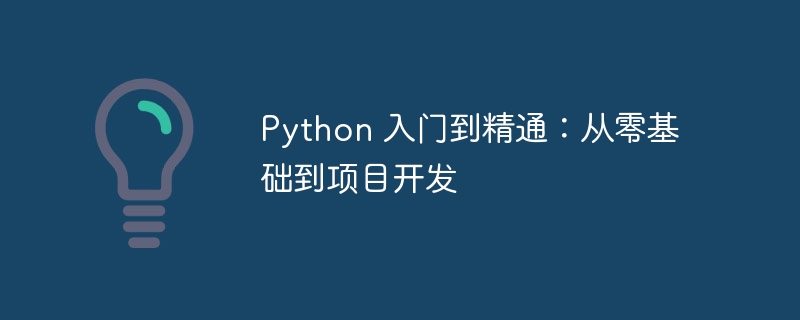Home >Backend Development >Python Tutorial >Python entry to proficiency: from zero basics to project development
Python entry to proficiency: from zero basics to project development
- 王林forward
- 2024-02-20 11:42:22957browse

1. Introduction to Python
python is a simple, easy-to-learn, powerful general-purpose programming language created by Guido van Rossum in 1991. The design concept of Python is to emphasize the readability of code and provide developers with rich libraries and tools to help them build various projects quickly and efficiently. kind of application.
2. Python basic syntax
The basic syntax of Python is similar to other programming languages, including variables, data types, operators, control flow statements, etc. Variables are used to store data. Data types define the data types that variables can store. Operators are used to perform various operations on data. Control flow statements are used to control the execution flow of the program.
3. Python data types
Data types in Python include integers, floating point numbers, strings, lists, tuples, dictionaries and sets, etc. Integers are integer values, floating point numbers are decimals, strings are character sequences, lists are ordered mutable sequences, tuples are ordered immutable sequences, dictionaries are collections of key-value pairs, and collections are unordered and non-repeating A collection of elements.
4. Python operators
Operators in Python include arithmetic operators, comparison operators, logical operators, assignment operators, etc. Arithmetic operators are used to perform operations such as addition, subtraction, multiplication, and division on data. Comparison operators are used to compare the values of two data. Logical operators are used to perform operations such as AND, OR, and NOT on data. Assignment operators are used For assigning values to variables.
5. Python control flow statement
Control flow statements in Python include if statements, while statements, for statements, etc. The if statement is used to execute different blocks of code based on a condition, the while statement is used to repeatedly execute a block of code until the condition is not met, and the for statement is used to iterate over the elements in the sequence.
6. Python function
Functions in Python are a mechanism for encapsulating blocks of code that can be called by other code. Functions can accept parameters and return results. Functions can be divided into two types: built-in functions and user-defined functions. Built-in functions are functions that come with Python, while user-defined functions are functions defined by programmers themselves.
7. Python module
Modules in Python are a mechanism that organizes related functions, classes, and variables together and can be imported and used by other code. Modules can be divided into two types: built-in modules and third-party modules. Built-in modules are modules that come with Python, while third-party modules are modules written by other programmers.
8. Python object-oriented programming
Python supports Object-oriented programming, and code can be organized through classes and objects. Classes are templates for objects, and objects are instances of classes. Classes can contain properties and methods. Properties are characteristics of an object, and methods are operations that an object can perform.
9. Python project development
After learning the basic knowledge of Python, you can start developing Python project. Project development can help you apply the knowledge you have learned to actual scenarios and exercise your programming skills. Python can be used to develop various types of projects, including WEB development, data analysis, machine learning, etc.
10. Summary
Python is an easy-to-learn, powerful programming language suitable for all kinds of people to learn. This article starts from scratch and gradually introduces Python's basic syntax, data types, operators, control flow statements, functions, modules, object-oriented programming, etc., and helps readers understand and master these knowledge points through demonstration code. I hope readers can learn the basics of Python through this article and be able to use Python to develop various useful applications.
The above is the detailed content of Python entry to proficiency: from zero basics to project development. For more information, please follow other related articles on the PHP Chinese website!

